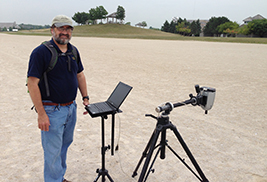Featured Article
Monitoring Lake Erie’s Algae From Space
Over the vast expanse of Lake Erie, sampling the water to test for potentially toxic algal blooms may seem like using a medicine dropper in an ocean. It takes days to collect enough data from enough spots to determine if the algae pose a danger.
read moreKent State’s Energy Conservation Project Yields Savings for the University
Posted Oct. 6, 2014 | Amanda Knauer
A new energy dashboard that will be released in the
future shows electricity usage for a Kent Campus
residence hall.
As part of the implementation of Kent State University’s 2008 Energy Conservation Master Plan, renovations to all residence halls, most academic buildings, auxiliary buildings (Intercollegiate Athletics, Recreational Services, Dining Services) and Regional Campuses have directly resulted in significant environmental and cost-saving developments for the university.
A total of 133 buildings underwent renovations under the first three phases with a budget of $51.8 million. From those projects alone, the reduction in greenhouse gas emissions is the annual equivalent to removing 3,475 cars from the road. Besides improving sustainability and energy efficiency, the projects also will save the university money. The projects will result in an annual utility savings of more than $4.7 million.
The conservation project consists of four phases. Phase one and two are completed, and phase three is expected to be completed in November. Phase four is waiting approval.
Bob Misbrener, project manager, and Scott Centea, associate mechanical engineer, both from Kent State’s Office of the University Architect, headed the projects that were started after House Bill 251 was signed into law in 2006.
“Ted Strickland, then governor of Ohio, set forth a requirement for all of the state-funded universities to prepare an energy conservation plan,” Misbrener says.
The resulting House Bill 251 set a goal for those universities to save 20 percent of their total energy use by fiscal year 2014 based upon energy use in 2004.
Campus Updates
The first phase began with updates to all Regional Campuses, with the exception of Kent State University at Tuscarawas, which handled its updates independently. The Regional Campus projects were completed in 2011, totaling $6.8 million. As a whole, all of the Regional Campuses in the program have met the original HB 251 goal.
Phase two involved the Kent Campus residence halls. This project was headed by Centea and was finished in summer 2014, costing about $20 million.
“Some of the common updates included lower-flow shower heads and lower-flow sink faucets,” Centea explains. “This means with every minute that someone is in the shower, we are saving at least a gallon of water.”
Other updates to all the residence halls included replacing the original fluorescent light fixtures with lower wattage fluorescent lights, for a nearly 40 percent savings while maintaining adequate lighting levels. In five of the buildings, the single-pane windows were replaced with double-pane, and all buildings had “smart” thermostats installed in each room and use occupancy sensors for every room.
“Occupancy sensors set back the room temperature when it’s unoccupied,” Centea says. “But when the student walks back in, it sets it back to the standard 72 degrees set point.”
The large mechanical systems were replaced in some halls. Centea says that the residence halls energy-reduction goal was met and exceeded.
The third phase includes renovations to the academic and auxiliary buildings on the Kent Campus. Misbrener led the first part of this project, which will be completed by November and totals $24.9 million.
Phase three involved many updates, including all new windows at University Library, roof replacements and new double-pane windows for several academic buildings. Lighting and occupancy sensors also were upgraded or added to most buildings. Major mechanical systems were replaced to serve some buildings. Almost all outdoor post and parking lot lights were replaced with LED lights, which use nearly three times less the original wattage while still improving the lighting, says Misbrener.
Utility metering also was added to all the buildings included in the energy projects. Misbrener says the meters will give the university information at the building level and show where future adjustments and improvements are needed to further reduce energy consumption.
Phase four will include even more improvements to buildings and is awaiting approval. The fourth phase is expected to meet and exceed the original energy-savings goal.
“This office and the leadership of the university are very interested in saving energy for the university and in being good stewards of the state and students’ money. All the projects are steps toward those goals,” Misbrener says.
For more information about the sustainability initiatives at Kent State, visit http://www2.kent.edu/universityarchitect/energy_conservation/index.cfm.
